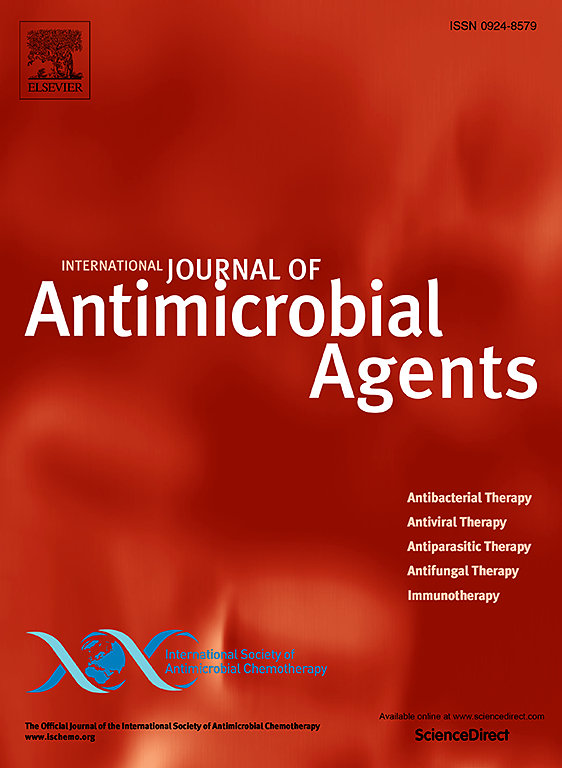头孢他林和头孢他啶/阿维巴坦在健康志愿者脑脊液中的浓度:药代动力学和达到目标的可能性
IF 4.6
2区 医学
Q1 INFECTIOUS DISEASES
International Journal of Antimicrobial Agents
Pub Date : 2025-04-14
DOI:10.1016/j.ijantimicag.2025.107512
引用次数: 0
摘要
目的测定头孢他林和头孢他啶/阿维巴坦在脑脊液(CSF)中的渗透程度,评价这两种药物治疗中枢神经系统(CNS)感染的潜力。方法在这项前瞻性、单中心药代动力学(PK)研究中,24名健康志愿者平均分为两组,分别接受600 mg头孢他林化石胺或2000/500 mg头孢他啶/阿维巴坦4次剂量静脉输注,每8 h间隔2 h。在两个研究日均采集血浆样本,并在最后一次腰椎穿刺输注开始后2小时、4小时或8小时对每位受试者采集一次脑脊液样本。采用非区隔分析和种群PK建模方法对PK数据进行了分析。通过蒙特卡罗模拟计算PK-PD指标达到的概率。结果两室模型描述了三种化合物的血浆PK数据。头孢他林、头孢他啶和阿维巴坦进入脑脊液和流出脑脊液的估计分布间隙之比分别为0.021、0.083和0.071,表明脑脊液渗透有限。头孢他林和头孢他啶在脑脊液中没有达到在常用的敏感性断点附近的最低抑制浓度,但暴露似乎足以治疗几种通常引起中枢神经系统感染的病原体。阿维巴坦浓度远低于报道的活性所需的阈值浓度。结论健康人脑脊液中头孢他林、头孢他啶和阿维巴坦分布较差。尽管如此,脑脊液暴露于这两种头孢菌素可能足以覆盖某些,但不是全部,引起中枢神经系统感染的病原体。本文章由计算机程序翻译,如有差异,请以英文原文为准。

Cerebrospinal fluid concentrations of ceftaroline and ceftazidime/avibactam in healthy volunteers: Pharmacokinetics and probability of target attainment
Objectives
This study measured the penetration of ceftaroline and ceftazidime/avibactam into cerebrospinal fluid (CSF) to evaluate the potential of both drugs for treatment of central nervous system (CNS) infections.
Methods
In this prospective, single-centre pharmacokinetic (PK) study, 24 healthy volunteers equally divided into two groups received four doses of either 600 mg ceftaroline fosamil or 2000/500 mg ceftazidime/avibactam as intravenous infusions over 2 h at 8 h intervals for 4 doses. Plasma samples were obtained on both study days and CSF was sampled once per subject at either 2 h, 4 h or 8 h after the start of the last infusion via lumbar puncture. PK data were analysed using non-compartmental analysis, as well as using a population PK modelling approach. Monte Carlo simulations were performed to calculate probability of PK-pharmacodynamic (PK-PD) target attainment.
Results
Two-compartment models described the plasma PK data for all three compounds. The ratios between the estimated distribution clearances into and out of the CSF were 0.021, 0.083 and 0.071 for ceftaroline, ceftazidime and avibactam, respectively, indicating limited CSF penetration. Ceftaroline and ceftazidime PK-PD targets were not attained in CSF for minimum inhibitory concentrations around commonly used susceptibility breakpoints, but exposure appears sufficient to treat several pathogens commonly causing CNS infections. Avibactam concentrations were well below reported threshold concentrations that are required for activity.
Conclusion
In healthy subjects, ceftaroline, ceftazidime and avibactam poorly distribute to CSF. Nonetheless, CSF exposure of both cephalosporins might be sufficient to cover certain, but not all, pathogens causative of CNS infections.
求助全文
通过发布文献求助,成功后即可免费获取论文全文。
去求助
来源期刊
CiteScore
21.60
自引率
0.90%
发文量
176
审稿时长
36 days
期刊介绍:
The International Journal of Antimicrobial Agents is a peer-reviewed publication offering comprehensive and current reference information on the physical, pharmacological, in vitro, and clinical properties of individual antimicrobial agents, covering antiviral, antiparasitic, antibacterial, and antifungal agents. The journal not only communicates new trends and developments through authoritative review articles but also addresses the critical issue of antimicrobial resistance, both in hospital and community settings. Published content includes solicited reviews by leading experts and high-quality original research papers in the specified fields.

 求助内容:
求助内容: 应助结果提醒方式:
应助结果提醒方式:


